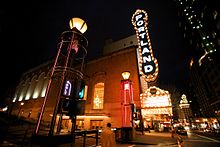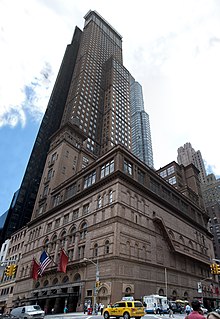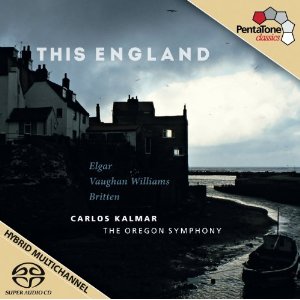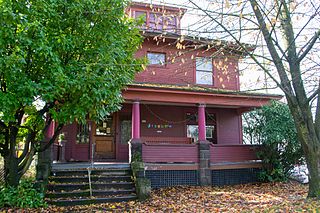Performances and broadcasts

The Oregon Symphony presented the program at the Arlene Schnitzer Concert Hall in Portland the evening of May 7 and the afternoon of May 8, 2011. [5] [6] Both performances were recorded for album release by the Boston-based company Soundmirror. [7] [8]
On May 12, the Oregon Symphony repeated the program at the inaugural Spring for Music Festival, marking the orchestra's Carnegie Hall debut. [5] [9] [10] The Symphony raised $300,000 to fund travel and hotel expenses for the concert series. [2] [10] In addition to the Oregon Symphony, the inaugural festival presented seven ensembles within nine days, including the Albany Symphony Orchestra, Dallas Symphony Orchestra, Montreal Symphony Orchestra, Orpheus Chamber Orchestra, Saint Paul Chamber Orchestra and Toledo Symphony Orchestra. [10] Orchestras were invited based on their submitted program proposals. [9] No other ensemble presented a program themed by a single topic. [1] In February 2011, three months before the Carnegie Hall performance, The Oregonian reported that nearly half of the 1,000 tickets reserved for distribution by the Oregon Symphony had been sold. [10] Kalmar later confirmed that 450 Oregonians traveled to New York City to witness the performance. [11]
The Carnegie Hall performance was broadcast live across the United States. [9] Portland's classical radio station, KQAC, broadcast the concert live throughout the Pacific Northwest as part of an ongoing partnership with the Symphony. [10] [12] [13] WQXR-FM, the classical radio station licensed to Newark, New Jersey and serving the New York City metropolitan area, broadcast the performance live in 3D sound in collaboration with the design and engineering consulting company Arup. [14] [15] WQXR also hosted a live chat on their website. [16] Prior to the live broadcast, WQXR's Q2 Music provided their own take on the Oregon Symphony's war-themed concert by airing a program with works by Lowell Liebermann, Seppo Pohjola, Steve Reich, Frederic Rzewski, Dmitri Shostakovich and John Adams. [17] KQAC rebroadcast the program in November. [18] In April 2012, the station broadcast the album recording and has since aired individual works. [19]
Reception (concert)

The concert program received a positive reception. [20] [21] The Oregonian's David Stabler wrote that during the May 7 performance the orchestra displayed peak condition and "played with a precision and intensity that would have been unattainable a decade ago". [1] He complimented Sylvan's diction and "emotional engagement", but noted that some words were difficult to make out. Stabler called the timpanist's performance during Britten's symphony "fierce" and the orchestra's playing "clear and intentional". [1] In his review of the Carnegie Hall performance, Stabler opined that the Oregon Symphony's program (which he described as one of "rage, brutality and fleeting beauty that required the utmost precision and ferocity from the musicians") focused more on playing, while the programs by other orchestras drew attention to the music. [22] Stabler wrote: "Everyone knows orchestras are fighting to survive, but on this night, the Oregon Symphony breathed long and deep of triumph." [22] In a separate article summarizing reviews by New York critics, Stabler called the Symphony a "virtuosos band" that "now plays with more acute rhythmic precision, more clarity, more informed style ... and more extreme dynamics and tempos". [23] James Bash of Oregon Music News wrote a positive review of the New York performance, describing it as more enhanced, dramatic and intense than the Portland concerts, partly because of the venue's superior acoustics. [24] Bash described the orchestra's performance of The Unanswered Question as "compelling and auspicious" and wrote that Sylvan's vocals during The Wound-Dresser "conveyed the sensitive text superbly". [24] In addition to complimenting the Symphony overall, Bash singled out solo performers by name. After noting the audience's enthusiastic response to the performance, including multiple bravos and particular recognition for Kalmar, Bash quipped "the Oregon Symphony may be regional in terms of size and budget, but they are world-class when they play". [24]
Following the New York concert, music critic Alex Ross tweeted: "Triumphant Carnegie debut for the Oregon Symphony -- best of Spring for Music so far. Eloquent Sylvan, explosive Vaughan Williams." [25] On his blog, "The Rest Is Noise", Ross called the Symphony's performance "extraordinary", one of the "most gripping events of the current season". [26] [27] [28] In his two-page review of Spring for Music for The New Yorker , Ross devoted more coverage to the Oregon Symphony than the other featured ensembles and considered Music for a Time of War the festival's highpoint. [29] [30] He complimented the orchestra for playing with "controlled intensity" and said of Symphony No. 4: "The Oregonians' furious rendition of that symphony would have been impressive in any context, but as the capstone to a brilliantly worked-out program it had shattering force." [27] The review contained an illustration of Kalmar, "hair flying and all". [30] Sedgwick Clark of Musical America called the orchestra's performance of the Williams' piece "positively searing ... with fearless edge-of-seat tempos ... breathtakingly negotiated by all." [28] [31] After Clark's review was published, Ross posted on his blog that he and Clark concurred: the Symphony's performance was the most "remarkable" of the season. [32] Ross included the Symphony's concert on his list of the most memorable classical performances of 2011. [33] Allan Kozinn, music critic for The New York Times , considered the program "pained" and "thought-provoking", and wrote that Sylvan performed with his "characteristic acuity". [4] He called the woodwind and brass playing in Sinfonia da Requiem "superb", specifically highlighting the "pointed" percussion in "Dies Irae" and the "haunting" string tone in "Requiem Aeternam". [4] Like Ross, Kozinn thought Symphony No. 4 was performed "with a furious, incendiary energy" that made an ideal ending to the program. [4]
In September 2011, the Symphony confirmed that Kalmar's contract, previously set to expire in 2013, had been extended until 2015. According to the organization, his contract was renewed "in recognition of his significant accomplishments", specifically acknowledging the Carnegie Hall performance. [34] The orchestra was invited to perform again at the 2013 Spring for Music Festival as one of two returning ensembles. [10] [35] [36] Kalmar said of the return invitation, "To be invited once is a thrill. To be invited twice is clear proof that we are in the artistic big leagues." [9] [10] However, in October 2012 the Symphony announced it would not accept the invitation for financial reasons. [37] [38]













